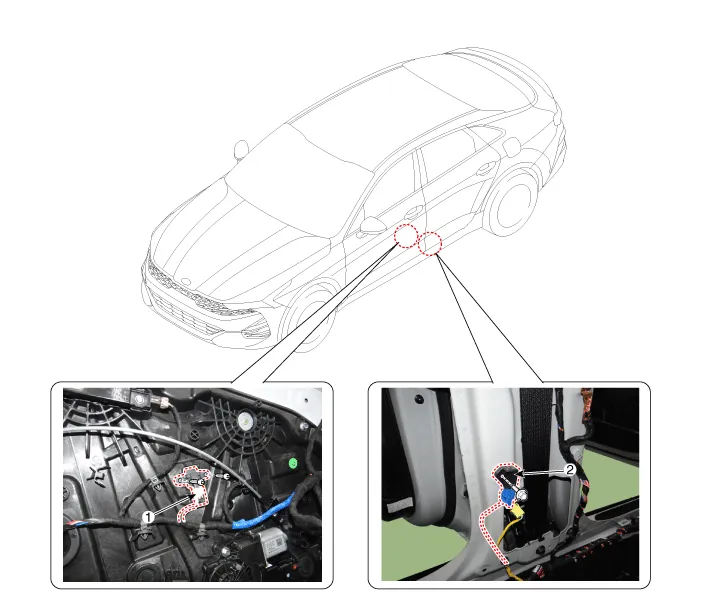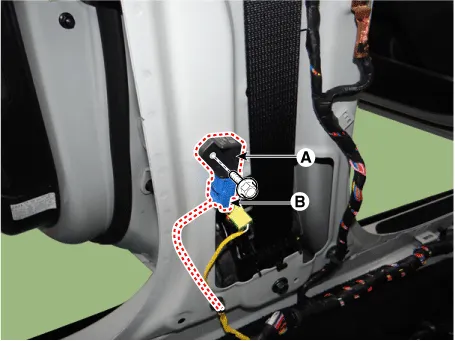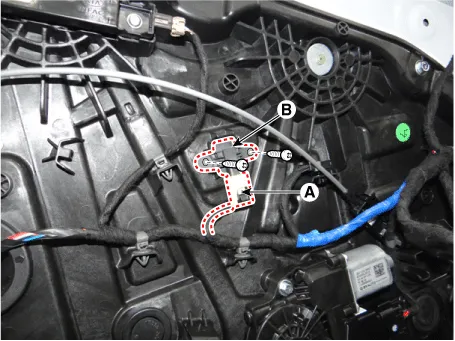Kia Optima DL3: SRSCM / Side Impact Sensor (SIS)
Description and operation
The Side Impact Sensor (SIS) system consists of two kinds of side impact sensor
which are installed at each center of the front door module (left and right) and
two rear sensors which are installed in the rear pillar (left and right).
| • |
The Front Side Impact Sensor is also called P-SIS because it detects
pressure due to collision at its mounting location.
|
| • |
The Rear Side Impact Sensor is also called A-SIS because it detects acceleration
due to collision at its mounting location.
|
SRSCM decides deployment of the airbag and the time of deployment through the
collision signal of the SIS when collision occurrs.
Components and components location

1. Pressure Side Impact Sensor
|
2. Gravity Side Impact Sensor
|
Repair procedures
Gravity Acceleration
side impact sensor (G-SIS)
| 1. |
Disconnect the negative battery terminal.
|
After disconnecting the cables, wait at least 3 minutes.
|
|
| 2. |
Remove the center pillar trim.
(Refer to Body - "Center Pillar Trim")
|
| 3. |
Remove the gravity side impact sensor (A) by loosening the bolt and then
disconnect the connector (B).
|
Tightening torque :
6.9 - 11.8 N·m (0.7 - 0.8 kgf·m, 5.0 - 5.8 lb·ft, 60.8 - 69.4
lb·in)
|

|
Pressure Side Impact
Sensor (P-SIS)
| 1. |
Disconnect the negative battery terminal.
|
After disconnecting the cables, wait at least 3 minutes.
|
|
| 2. |
Remove the front door trim.
(Refer to Body - "Front Door Trim")
|
| 3. |
Remove the connector (A) and turn it counterclockwise to remove the pressure
side impact sensor (B).
|
Tightening torque :
2.0 - 2.9 N·m (0.2 - 0.3 kgf·m, 1.4 - 2.2 lb·ft, 17.4 - 26.0
lb·in)
|

|
| • |
Do not turn the ignition switch ON and do not connect the battery
cable while replacing the side impact sensor.
|
|
Pressure Side Impact
Sensor [P-SIS (Door)]
| 1. |
Install the new front side impact sensor with the screws, then connect
the front side impact sensor connector.
|
Tightening torque :
6.9 - 11.8 N·m (0.7 - 0.8 kgf·m, 5.0 - 5.8 lb·ft, 60.8 - 69.4
lb·in)
|
| •
|
Use specified bolts only.
|
|
|
| 2. |
Install the front door trim.
(Refer to Body - "Front Door Trim")
|
| 3. |
Reconnect the battery negative cable.
|
| 4. |
After installing the front side impact sensor, confirm proper system
operation:
Turn the ignition switch ON; the SRS indicator light should turn on for
about six seconds and then go off.
|
Gravity Side Impact
Sensor [G-SIS (B-Pillar)]
| • |
Do not turn the ignition switch ON and do not connect the battery
cable while replacing the side impact sensor.
|
|
| 1. |
Install the side impact sensor with the bolt then connect the side impact
sensor connector.
|
Tightening torque :
2.0 - 2.9 N·m (0.2 - 0.3 kgf·m, 1.4 - 2.2 lb·ft, 17.4 - 26.0
lb·in)
|
|
| 2. |
Install the center pillar trim.
(Refer to Body - "Center Pillar Trim")
|
| 3. |
Reconnect the battery negative cable.
|
| 4. |
After installing the pressure side impact sensor, confirm proper system
operation:
| • |
Turn the ignition switch ON; the SRS indicator light should be
turned on for about six seconds and then go off.
|
| •
|
You must comply with the specified tightening torques
with the tool specified because Gravity – Side Impact Sensors
(G-SIS) may be broken or POP-NUT may be rotated.
|
| •
|
Problems may be occurred in the durability of G-SIS or
impact sensing performance may be depreciated if POP-NUT
is rotated.
|
| •
|
The door module must not be transformed because SRSCM
judges a impact through the pressure sensor in the door
module.
|
|
|
Description and operation
Description
The front impact sensor (FIS) is installed in the Front End Module (FEM). They
are remote sensors that detect acceleration due to a collision at its mounting location.
Other information:
Schematic diagrams
Connector and Terminal Function
Repair procedures
Removal
When prying with a flat-tip screwdriver or use a prying trim tool, wrap
it with protective tape, and apply protective tape around the related parts,
to prevent dam
Repair procedures
Removal
Interior Antenna 1
1.
Disconnect the negative battery terminal.
2.
Remove the surround view monitor (SVM) unit.
(Refer to Advanced Driver Assistance System (ADAS) - "Surround View Monitor
(SVM) Unit")
3.




